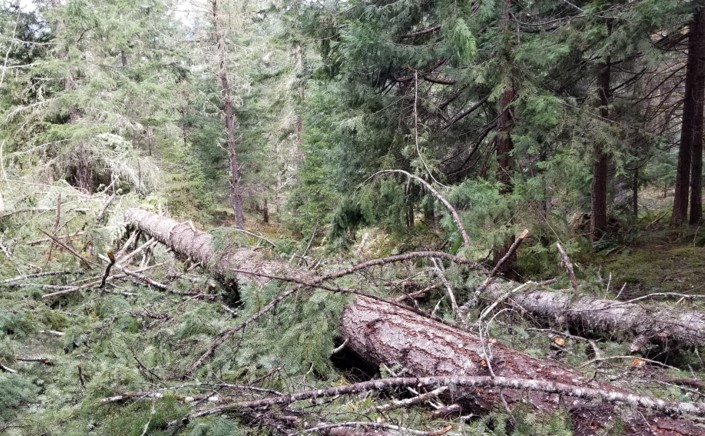By Lauren Grand, OSU Forestry and Natural Resources Extension Agent, Lane County

I’m sure you all remember the huge snowstorm we had in March. Of course you do! How could anyone forget being stuck in their home for days or even weeks without electricity? (Strike 1) The beautiful winter wonderland lasted a few weeks, but eventually melted to reveal a huge mess of fallen trees and broken tops (Strike 2). Now summer is here, and you are trying your best to clean up some of that mess. This might include trying to salvage some value from the fallen and damaged trees. So, you call the local log buyers and …STRIKE 3!!!
So many landowners, large and small, were affected by the snowstorm that the market is starting to become overwhelmed with small diameter, snow damaged logs. Sawmills are currently buying modestly in hopes that they don’t build up their inventory too much. If you’ve got logs that are 2mil or are in the 8-11 inch top sorts then prices are not too bad, ranging from $600-650/MBF. While this price SEEMS shockingly low (are we remembering prices to be $100 higher last year?), if you consider the three-year trend in the graph above, these prices are more historically in line with summer pricing. Here comes the tough news: if all you have are small diameter logs with 5-7 inch tops, you may have a hard time finding a buyer. If you do find a buyer, prices may drop another $100/MBF. If your damaged trees are even smaller than that, selling to a fiber mill for chips is always an option, but the chip market has come down with prices at $28-29/ton.

The Hem-fir sorts (spruce, hemlock, grand and white fir) are remaining pretty stable if not decreasing slightly. If you can find a buyer, long logs are in the $435 – $485 range. If you’ve got really rough looking logs, prices may dip to the $300 range. Roseburg’s prices are slightly higher ranging from $425-$500.
Unfortunately, the story of ponderosa pine is getting tired. There aren’t a lot of buyers, prices are down, and uncertainty in the Chinese tariffs are keeping people conservative. Prices in Lane County saw a small rise to $320. Prices usually increase slightly more down south. If you are selling pine, consider your trucking distance. At these prices, if you have to move it too far, you may be losing money instead of making it. That being said, rumors of light at the end of the tunnel are starting to surface. Hopefully I’ll have some higher prices for you with my next report, but no promises.
Harvesting of red alder seems to be slowing as a response to the softer lumber market and China tariffs. Despite this, prices are remaining steady since my last report. Alder is hovering around $600/MBF for the 8” and up sorts. More realistic log sizes/values show prices at $70 – 80/ton and $400 for 6” and 7” logs.
Incense-cedar and redcedar prices are holding steady from the last report as well. Current values of incense-cedar in the south valley are running close to $650 for long logs. Incense-cedar in Douglas County is usually purchased at slightly higher values. Western redcedar prices are still lower than they have been in the recent past and are holding at $850/MBF for a long-log and $50 less in Roseburg. Short log values decline by another $100-$200 depending on the length. Redcedar demand isn’t what it has been because the mills have a good inventory at the moment.
“Landowners are focusing on poles for their harvest while they wait in hopes for sawlog prices to come back up in the fall.”
Poles are continuing to go strong and look irresistible to sellers who are missing those late 2017 and early 2018 prices. Because of this, landowners are focusing on poles for their harvest while they wait in hopes for sawlog prices to come back up in the fall. Historically, pole values are steady in large part to the increased time between harvest and end-use. They also aren’t tied to the lumber market which is down at the moment. Despite my excitement about poles staying solid, the prices have come off a bit since my last report. Poles less than 65 feet are bringing in about $100 less than earlier this year and are sitting in the $900/MBF range. Prices increase as length increases. Long poles are currently selling around $1100.

In the non-timber forest products world, cascara is king. A real mover and shaker, just be careful handling it or you’ll only be moving to the nearest bathroom! Cascara bark is currently being purchased at $0.45/ pound green and $1.25 per pound dry. I’ve also been hearing that summer chanterelles are starting.
As this report comes to a close, I’m working on staying on the brighter side of things. While the snowstorm gave everyone a run for their money, prices aren’t dropping that much. Usually we see larger dips in the summer as a result of more sellers entering the market, but this year things are fairly steady from last quarter. If you are working on a harvesting project make sure you communicate with your local log buyers, consultants, and loggers early. And always get your purchase order before you cut!


